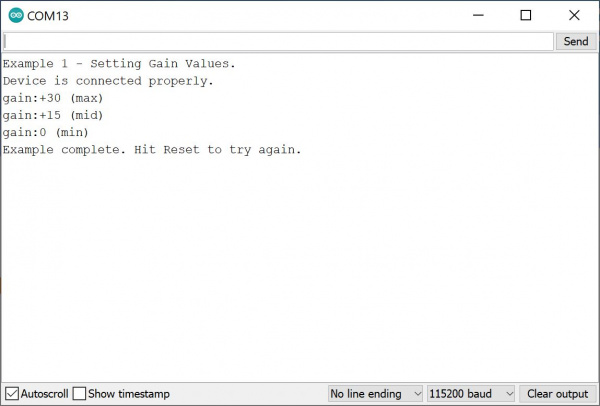Qwiic Speaker Amp (TPA2016D2) Hookup Guide
Example 1: Gain Control
Let's upload the sketch to control the gain for the Qwiic Speaker Amp using an Arduino microcontroller.
From the menu, select the following: File > Examples > Examples from Custom Libraries | SparkFun TPA2016D2 Arduino Library > Example_01_Gain.
Or you can copy and paste the following code in the Arduino IDE. Select the correct board definition from the menu (in this case, Tools > Boards > Arduino Uno). Then select the correct COM port that the board enumerated to (in this case, it was COM13). Hit the upload button.
language:c
/******************************************************************************
Example _01_Gain.ino
Sets a few different gain values on the TPA2016D2 speaker amp.
Note, when gain is "0", it still passes sound through.
To turn the sound off, use shutdown or enable/disable examples.
Note, you can't REALLY turn off the AGC on the TPA2016D2,
But if you disable the limiter, noisegate, and set fast release/attack
times, then it only minimally effects gain changes.
SparkFun TPA2016D2 Arduino Library
Pete Lewis @ SparkFun Electronics
September 8, 2022
https://github.com/sparkfun/SparkFun_TPA2016D2_Arduino_Library
This code was originally created by Mike Grusin at SparkFun Electronics
Included with the LilyPad MP3 example code found here:
Revision history: version 1.0 2012/07/24 MDG Initial release
https://github.com/sparkfun/LilyPad_MP3_Player
Do you like this library? Help support SparkFun. Buy a board!
SparkFun Qwiic Speaker Amp - TPA2016D2
https://www.sparkfun.com/products/20690
Development environment specifics:
IDE: Arduino 1.8.19
Hardware Platform: SparkFun Redboard Qwiic
SparkFun Qwiic Speaker Amp - TPA2016D2 Version: 1.0
Hardware Connections:
Use a qwiic cable to connect from the Redboard Qwiic to the Qwiic Speaker Amp.
Connect audio-in, speakers, and power to the Qwiic Speaker Amp.
For information on the data sent to and received from the amplifier,
refer to the TPA2016D2 datasheet at:
http://www.ti.com/lit/ds/symlink/tpa2016d2.pdf
This program is distributed in the hope that it will be useful,
but WITHOUT ANY WARRANTY; without even the implied warranty of
MERCHANTABILITY or FITNESS FOR A PARTICULAR PURPOSE. See the
GNU General Public License for more details.
You should have received a copy of the GNU General Public License
along with this program. If not, see <http://www.gnu.org/licenses/>.
******************************************************************************/
#include <Wire.h>
#include <SparkFun_TPA2016D2_Arduino_Library.h> //Click here to get the library: http://librarymanager/All#SparkFun_TPA2016D2
TPA2016D2 amp;
void setup()
{
Serial.begin(115200);
Serial.println("Example 1 - Setting Gain Values.");
Wire.begin();
if (amp.begin() == false) //Begin communication over I2C
{
Serial.println("The device did not respond. Please check wiring.");
while (1); //Freeze
}
Serial.println("Device is connected properly.");
// for gain control to react to changes quickly, we need to adjust some of the AGC settings as so...
amp.disableLimiter(); // note this also changes compression ratio to 1:1, then disables limiter.
amp.disableNoiseGate(); // disabling the noisegate allows us to always change the gain, even with very little sound at the source.
amp.writeRelease(1); // 1-63 are valid values. 1 being the shortest (aka fastest) release setting, this allows gain increases to happen quickly.
amp.writeAttack(1); // 1-63 are valid values. 1 being the shortest (aka fastest) attack setting, this allows gain decreases to happen quickly.
Serial.println("gain:+30 (max)");
amp.writeFixedGain(30); // aka "full gain at +30dB", accepts values from 0 to 30
delay(5000);
Serial.println("gain:+15 (mid)");
amp.writeFixedGain(15);
delay(5000);
Serial.println("gain:0 (min)");
amp.writeFixedGain(0);
delay(5000);
Serial.println("Example complete. Hit Reset to try again.");
}
void loop()
{
// nothing to see here.
}
Hit the play button on your portable digital player to begin sending audio to amplifier and speakers. Make sure that the volume on your device is turned up as well. Open the Arduino Serial Monitor at 115200 if you need to see the serial output when the gain adjusts. You should see the example adjust the gain once based on the settings and the audio getting quieter every 5 seconds.
Note that a gain of "0" will still pass the audio signal to the speakers. If you are looking to turn the speakers fully off (i.e. "0" volume), try adding code from example 2 to disable the channel or example 3 to shutdown the amplifier.
// for gain control to react to changes quickly, we need to adjust some of the AGC settings as so...
amp.disableLimiter(); // note this also changes compression ratio to 1:1, then disables limiter.
amp.disableNoiseGate(); // disabling the noisegate allows us to always change the gain, even with very little sound at the source.
amp.writeRelease(1); // 1-63 are valid values. 1 being the shortest (aka fastest) release setting, this allows gain increases to happen quickly.
amp.writeAttack(1); // 1-63 are valid values. 1 being the shortest (aka fastest) attack setting, this allows gain decreases to happen quickly.
